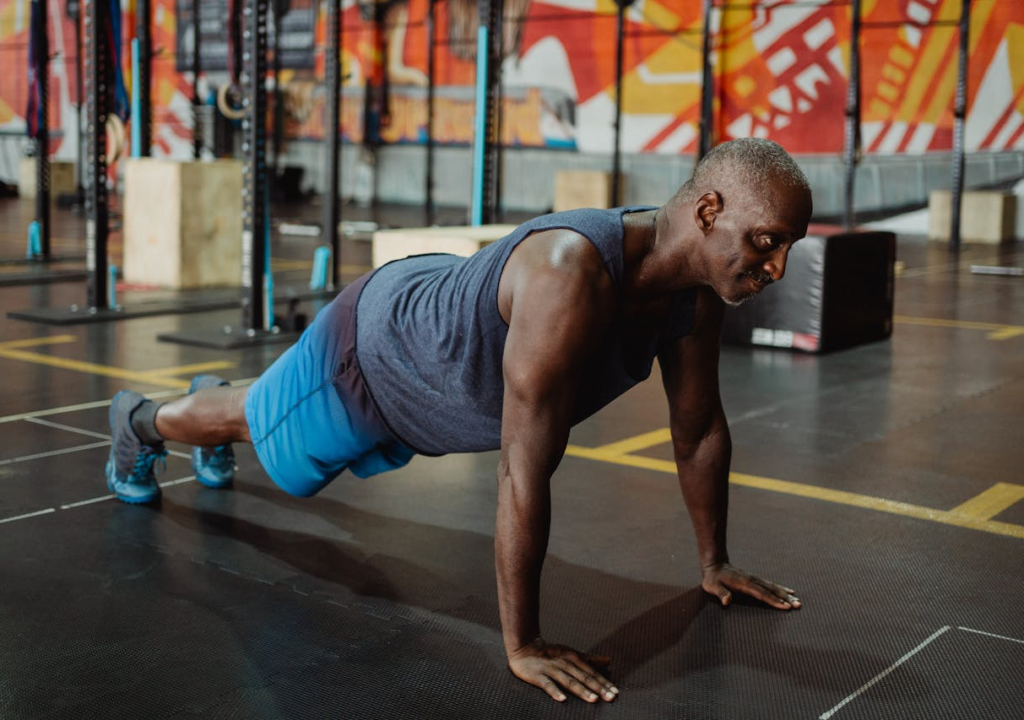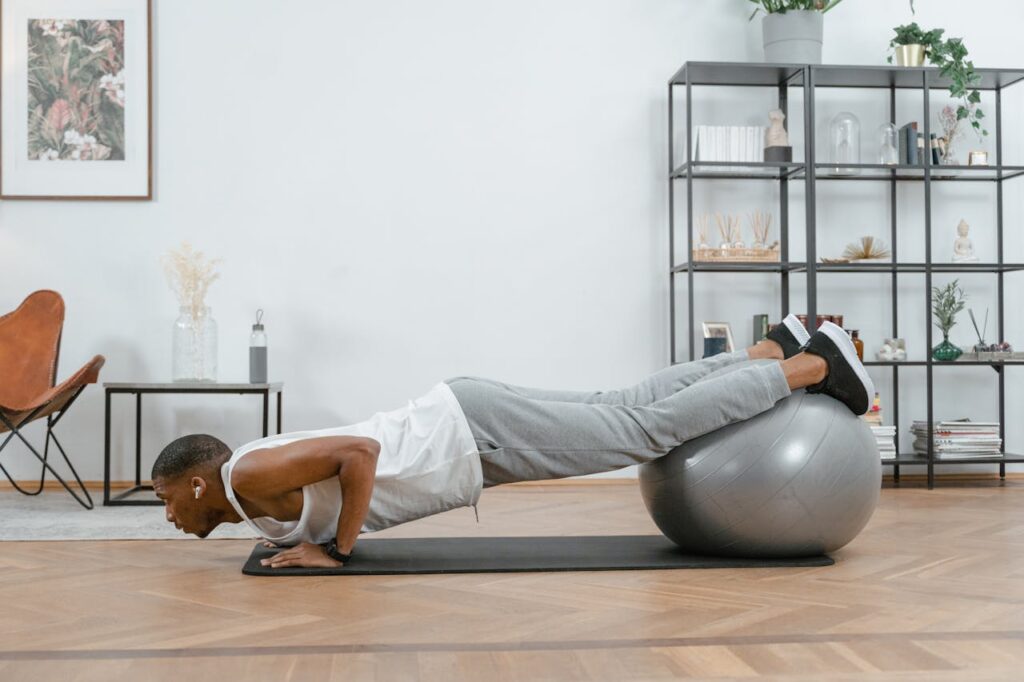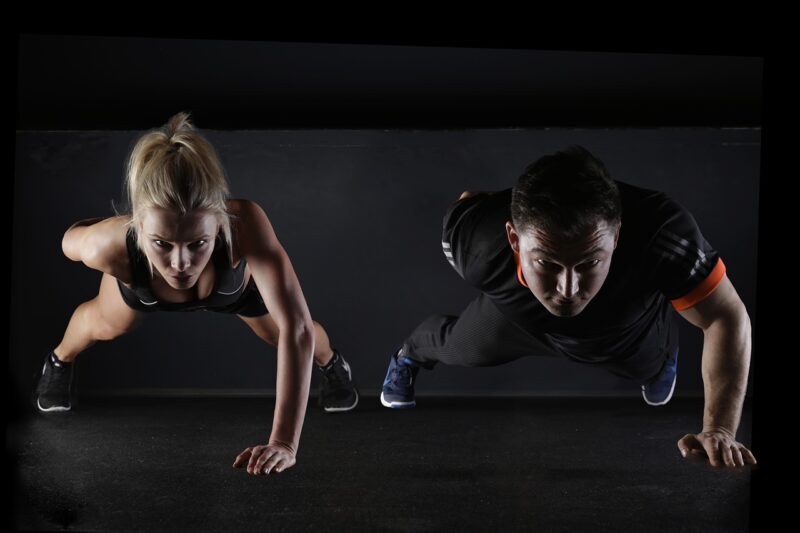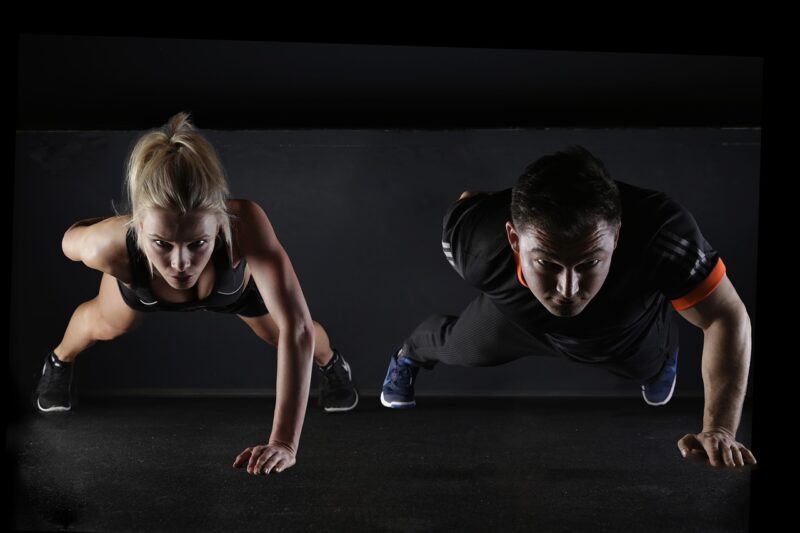Last Updated on October 3, 2025 by shawnshealth
Discover how to master different push ups with these 7 powerful progressions. Build strength, improve fitness, and take your push-up game to the next level!
How to Master Different Push Ups: 7 Progressions for Strength and Fitness
Different push ups are foundational exercises that target the chest, shoulders, triceps, and core. While the basic push up is incredibly effective, there are many variations that you can progress through to build strength, improve fitness, and challenge yourself in new ways. In this article, we will walk you through 7 push up progressions, from the basic version to advanced variations, including the ultimate challenge: the one-arm push up.
According to WebMD, push-ups can improve heart health, bone strength, and overall longevity.
1. What Are Push-Ups?
Push-ups are a bodyweight exercise that strengthens the chest, shoulders, triceps, and core. There are many different push-ups, each targeting muscles differently. They help improve endurance, build strength, and enhance overall fitness.
2. What Are Push-Up Progressions?
Push-up progressions help you master different push-ups by adjusting difficulty. Examples include:
- Wall Push-Ups – Beginner-friendly.
- Knee Push-Ups – Less resistance.
- Standard Push-Ups – Full-body movement.
- Diamond Push-Ups – Focuses on triceps.
- Archer Push-Ups – Builds unilateral strength.
- One-Arm Push-Ups – Advanced level.
3. How Can I Improve My Push-Up Strength?
To get better at different push-ups:
- Perfect Form – Keep your body aligned.
- Increase Reps – Build endurance.
- Use Progressions – Scale difficulty.
- Train Supporting Muscles – Add dips and planks.
- Stay Consistent – Practice regularly.
Take a look at this video from Hybrid Calisthenics for progressions to full pushups. Then be sure to continue on as this article discusses beginner all the way to VERY ADVANCED.
Table of Contents
As an Amazon Associate, I earn from qualifying purchases. This means I may receive a commission if you purchase through links on this site, at no extra cost to you.
The information in this article is for general informational purposes only and is not intended as medical advice. Please consult with a healthcare professional before starting any new fitness routine or making changes to your health regimen.
Author’s Tips for Mastering Different Pushups
I used to be the “no pain no gain” guy. I used to think that I hadn’t worked out if my body wasn’t weak and trembling afterwards. I was young, and my body allowed that for a while, but it’s not a good way to train.
Allow your body to get stronger. Don’t force it. Just do your program. Go to 1-3 reps shy of failure on each set or until the last set where you can go to failure, as long as you keep proper form. Focus on increasing reps (or by adding weight/resistance) as your body says “Hey. This isn’t too hard, let’s do another!”
Consistency over intensity. It’s so much more effective to stick with your workout routine over the long haul, gradually increasing reps/progressions, rather than trying to give yourself “noodle arms” where you can’t even brush your teeth.
Seriously, I’ve been that guy. Don’t be that guy.
Blessings
Feel free to check out my article on working out in small spaces like hotel rooms—including pushups—by visiting this guide on hotel room workouts.
Check out this video from Jeremy Ethier for a great demonstration of how to properly do a full pushup!
How to Master Different Push Ups: 7 Progressions for Strength and Fitness
Different push ups are foundational exercises that target the chest, shoulders, triceps, and core. While the basic push up is incredibly effective, there are many variations that you can progress through to build strength, improve fitness, and challenge yourself in new ways. In this article, we will walk you through 7 push up progressions, from the basic version to advanced variations, including the ultimate challenge: the one-arm push up.
1. The Basic Push Up
If you’re new to push ups, the basic version is where you should begin. It’s the most essential and fundamental form, targeting the chest, shoulders, and triceps while also requiring stability from the core.
How to Perform the Basic Push Up:
- Start in a high plank position with your hands placed shoulder-width apart and your feet together.
- Lower your body toward the ground by bending your elbows, keeping them at about a 45-degree angle or closer to your sides.
- Push through your palms to return to the starting position, ensuring that your body stays in a straight line from head to heels.
- Aim for 3 sets of 10-15 repetitions, gradually increasing as your strength improves.

2. Incline Push Ups
If you’re looking for a slightly easier variation to the basic push up, incline push ups are a great option. They reduce the load on your upper body by elevating your hands on a raised surface, such as a bench, counter, or bar. This makes the exercise less taxing on the shoulders and chest and if a great way to transition into basic pushups on the floor.
How to Perform Incline Push Ups:
- Place your hands on an elevated surface, such as a sturdy bench or countertop, keeping your body in a straight line from head to heels.
- Lower your chest towards the surface by bending your elbows, then push yourself back up to the starting position.
- Start with a higher incline, such as a counter, and lower the incline over time as you build strength.
Incline push ups are a perfect way to get accustomed to push ups without the full load of the bodyweight variation.

3. Wide Push Ups
Wide push ups are a more challenging variation of the basic push up, designed to place more emphasis on the chest muscles. By spreading your hands wider than shoulder-width, you create a larger range of motion, forcing your chest and shoulders to work harder.
How to Perform Wide Push Ups:
- Start in the same position as the basic push up, but position your hands wider than shoulder-width apart.
- Lower your chest toward the floor, ensuring your elbows are bent outward at a 45-degree angle. Caution: Even though your hands are wider, keep that 45-degree angle without splaying out your elbows.
- Push back up to the starting position.
Wide push ups also increase the involvement of the anterior deltoids, making them a great way to build upper body strength.

4. Decline Push Ups
The decline push up is an advanced variation that places more emphasis on the upper chest and shoulders. By elevating your feet, you shift some of your body weight onto your upper body, making the push up more challenging.
How to Perform Decline Push Ups:
- Place your feet on a raised surface, such as a bench or step, and your hands on the floor at shoulder-width apart.
- Lower your chest toward the floor by bending your elbows, keeping your body in a straight line.
- Push through your palms to return to the starting position.
Decline push ups are an excellent way to target your upper chest and deltoids while building strength for more advanced push up variations.

5. Diamond Push Ups
Diamond push ups focus on the triceps by positioning the hands close together underneath your chest. The hands form a diamond shape with the fingers and thumbs, which forces the triceps to take on a greater load.
How to Perform Diamond Push Ups:
- Start in the basic push up position but bring your hands together directly beneath your chest so that your index fingers and thumbs form a diamond shape.
- Lower your body towards the floor, keeping your elbows close to your sides.
- Push back up to the starting position.
This variation is great for strengthening the triceps and increasing overall upper body stability.

6. Plyometric Push Ups
Plyometric push ups are an explosive variation that can help develop power and strength in your upper body. By adding an explosive push at the top of the movement, you increase the intensity and work your muscles in a new way.
How to Perform Plyometric Push Ups:
- Start in a standard push up position.
- Lower your body toward the floor, then explosively push off the ground with enough force to lift your hands off the floor.
- Land softly with your hands back in the starting position and immediately go into the next repetition.
Plyometric push ups are excellent for athletes or anyone looking to improve upper body power and explosive strength.

7. One-Arm Push Up
The one-arm push up is the pinnacle of push up variations. It’s a true test of strength, balance, and coordination. It requires much more than just removing one arm from a regular push up; the one-arm push up forces you to engage your core, shoulders, chest, and stabilizing muscles in a way that no other push up variation does.
Check out this video. This example is of a nearly perfect (is there such a thing as “perfect”) ONE ARM PUSHUP. Not the crazy side twisting one arm pushups that you see in videos and in high schools across the country. Strive for this level! Then continue below to learn how you can achieve this as well!
Special Section: How to Transition to One-Arm Push Ups
The one-arm push up requires full body control, balance, and strength, making it a more complex movement than simply doing a regular push up with one arm. Transitioning to one-arm push ups takes time, but with the right progressions, you can achieve it. Here’s a guide to help you master the one-arm push up:
- Build Strength with Regular Push Ups
First, you need to develop a solid foundation of strength. This includes mastering the basic push up, decline push ups, and wide push ups. These variations target the chest, shoulders, and triceps, which are essential for the one-arm push up. - Strengthen Your Core
Your core plays a critical role in the one-arm push up. Exercises like planks, leg raises, and side planks will help develop the stability needed to keep your body aligned during the one-arm push up. - Practice Isometric Holds
Before attempting the one-arm push up, practice holding the position of a regular push up with one arm. Start with your feet wider apart and your non-working hand raised in front of you for balance. Hold the position for as long as you can, focusing on engaging your core and maintaining stability. You can add shoulder touches to this. - Incline One-Arm Push Ups
To make the one-arm push up more manageable, start by performing incline one-arm push ups on an elevated surface like a counter, bar, or piece of furniture. This reduces the amount of torque and load on your body, giving you the chance to build the strength and stability required.
I have to interject here that your form should be as good as possible regardless of what incline you are at. If you are doing one arm pushups against the kitchen counter (for example) focus on keeping your body rigid, feet about 12 inches apart (you can start wider until you build up to that), shoulders square (not at an angle), and perfect that form so when you decrease your incline (say from counter height to coffee table height) you will already have a very solid foundation.
- Reduce the Incline and Progress
As you become more comfortable with the incline one-arm push up, begin lowering the height of the surface you’re using. Gradually reduce the incline until you’re able to perform the exercise with your hands on the floor. Eventually, you will be able to attempt the full one-arm push up on flat ground. - Master the Full One-Arm Push Up
Once you’ve mastered the incline one-arm push up with your feet closer together, you’ll be ready to attempt the full one-arm push up. Ensure you keep your body straight, engage your core, and push yourself up with control. It’s a tough move, so be patient and practice frequently.
📘 Want expert insight on push-up strength? Read this MasterClass guide on building strength with pushups for tips on form, benefits, and progression strategies

Final Thoughts
Mastering different push ups is about gradually increasing the challenge to build strength, stability, and endurance. From the basic push up to the advanced one-arm push up, each progression builds on the previous one to help you become stronger and more capable.
As you work through these push up variations, remember to focus on form, consistency, and gradual progression. Mastery of push ups isn’t just about muscle—it’s about control, stability, and perseverance. Stick with it, and you’ll see significant improvements in your strength and overall fitness.
Want to learn more about bodyweight training? Check out The Ultimate Calisthenics FAQ: Everything You Need to Know About Bodyweight Training for a complete guide to calisthenics, including exercises, tips, and expert advice to help you get stronger and move better.
🧭 Want to build strength that actually helps in real life? Check out my article on 👉 survival fitness—a practical approach to training that includes pushups and other functional movements designed to keep you strong, capable, and ready for anything.
🔥 Gear to Help You Achieve Your Health and Fitness Goals 💪
If you’re looking for tools to enhance your fitness journey, check out this. Explore top-rated fitness gear on Amazon to enhance your workouts. Check out the latest picks here! 🛒 to support your workouts and progress.
🚀 Find equipment designed to boost strength, endurance, and overall performance!
⚠️ Short disclaimer: As an Amazon Associate, I earn from qualifying purchases.
💡 Frequently Asked Questions: Mastering Different Push-Ups
What are the benefits of mastering different push-up variations?
- Builds upper body and core strength
- Improves muscle balance and stability
- Targets multiple muscle groups from different angles
- Helps break fitness plateaus
- Enhances functional fitness and joint control
How can I improve my push-up technique?
- Keep your body in a straight line from head to heels
- Engage your core and glutes throughout the movement
- Lower your body with control—don’t let it drop
- Hands should be just wider than shoulder-width
- Avoid flaring elbows; keep them at about a 45-degree angle
What’s the best way to progress to harder push-up variations?
- Master basic push-ups with perfect form
- Add reps and sets to build endurance
- Gradually increase difficulty: incline → flat → decline → one-arm
- Incorporate tempo control (slow down the eccentric phase)
- Add weight or resistance bands once bodyweight feels easy
How often should I train push-ups?
- Beginners: 2–3 times per week with adequate rest days
- Intermediate: 3–4 sessions per week, mixing variations
- Advanced: Up to 5 times per week, focusing on skill and intensity
- Listen to your body and allow muscle recovery
What are some easy push-up variations for beginners?
- Wall push-ups
- Incline push-ups (on a bench or table)
- Knee push-ups
- Negative push-ups (slowly lower down only)
- Box push-ups (hands elevated, feet on the ground)
What are the most advanced push-up variations?
- Archer push-ups
- Typewriter push-ups
- Clapping or plyometric push-ups
- One-arm push-ups
- Handstand push-ups (requires wall or freestanding balance)
Are push-ups enough to build muscle?
- Yes, especially when you:
- Use progressive overload with variations
- Focus on slow tempo and high volume
- Target different angles and ranges of motion
- Combine push-ups with pull and leg movements for full-body development
Can I do push-ups every day?
- Yes, but only if you:
- Rotate push-up types and intensities
- Avoid overuse injuries by monitoring soreness
- Prioritize form and recovery
- Include rest or light days to allow muscle growth
✅ Ready to take your push-up skills to the next level? Visit shawnshealth.com for full bodyweight routines, progression guides, and fitness tips tailored to every level.
He gives strength to the weary and increases the power of the weak. – Isaiah 40:29




